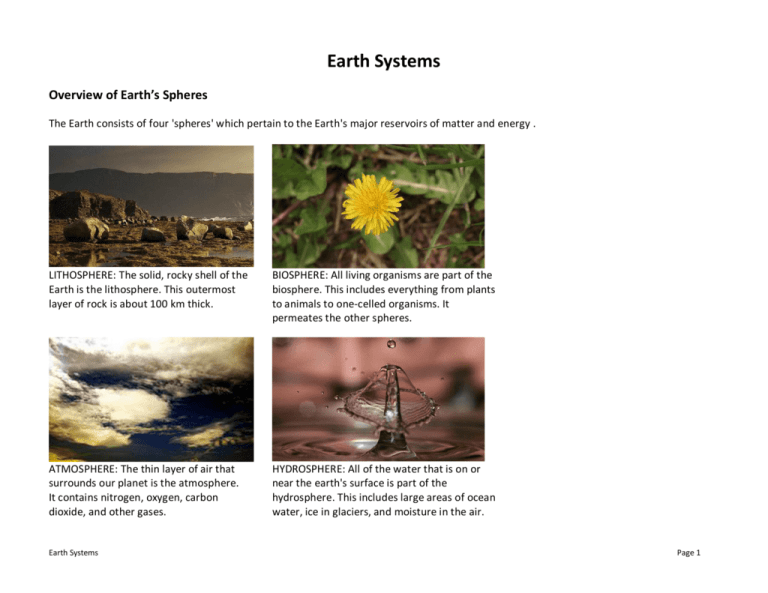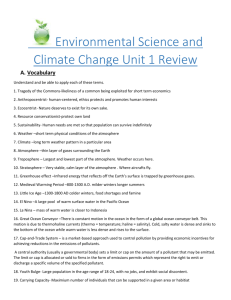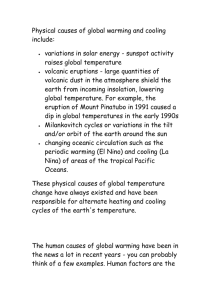WELIM Solar Energy
advertisement

Earth Systems Overview of Earth’s Spheres The Earth consists of four 'spheres' which pertain to the Earth's major reservoirs of matter and energy . LITHOSPHERE: The solid, rocky shell of the Earth is the lithosphere. This outermost layer of rock is about 100 km thick. BIOSPHERE: All living organisms are part of the biosphere. This includes everything from plants to animals to one-celled organisms. It permeates the other spheres. ATMOSPHERE: The thin layer of air that surrounds our planet is the atmosphere. It contains nitrogen, oxygen, carbon dioxide, and other gases. HYDROSPHERE: All of the water that is on or near the earth's surface is part of the hydrosphere. This includes large areas of ocean water, ice in glaciers, and moisture in the air. Earth Systems Page 1 Integrated Spheres Within a single location near the surface of the Earth, one can often encounter all four of Earth’s spheres. Let’s take soil as an example. The lithosphere is present as the mineral material composing the soil. The hydrosphere is there as moisture in the soil. The biosphere is present as insects crawling through the soil or plants growing in the soil. The atmosphere is also there as air pockets between the pieces of soil. Earth Systems Page 2 Carbon Cycle Human civilization developed under natural levels of greenhouse warming. Extra carbon in the atmosphere is leading to global warming over and above natural levels. Each of the Earth’s spheres contains carbon. Carbon is found in the atmosphere mostly as carbon dioxide, an important greenhouse gas. Carbon is found in the lithosphere stored in carbonate rocks. It is also found in fossil fuels, such as oil, coal, and natural gas. Carbon is found in the biosphere stored in plants and trees. It is a basic building block of life. Carbon is found in the hydrosphere dissolved in ocean water and lakes. The flux of carbon from one area to another is the basis for the carbon cycle. As carbon moves between the spheres, it affects or is affected by climate change. Earth Systems Page 3 Carbon from the Earth Carbon emerges from volcanoes in the form of carbon dioxide and thus enters the atmosphere. Carbon is subducted into the Earth’s mantle during plate tectonics and erupted from volcanoes. Carbon is removed from ocean water and used to make the shells of marine organisms which later die and fall to the ocean bottom as sediment. The largest carbon reservoir is in the rocks of the Earth. This reservoir is largely 'locked up' and unavailable to the atmosphere or living organisms. However, there are a few ways that carbon does get into the atmosphere. Earth Systems Carbon is moved by man into the atmosphere. In the lithosphere, carbon is stored for millions of years as fossil fuels, including oil, natural gas, and coal. By burning fossil fuels, people move carbon from long-term geologic storage into the atmosphere. Page 4 Carbon from the Ocean Carbon is dissolved in ocean water. The exchange of carbon dioxide between the atmosphere and ocean is a critical aspect of climate change. As carbon dioxide increases in the atmosphere, the ocean absorbs the extra carbon dioxide to maintain chemical equilibrium. This is called the solubility pump. But the solubility pump is slowing down. Unfortunately, the solubility of carbon dioxide in water is temperature dependent. So, as global warming causes the ocean’s temperature to increase, less carbon dioxide can be dissolved into the ocean. And the biological pump is slowing down too. The biological pump moves carbon from the surface water to the ocean floor where it is subducted into the lithosphere. However, additional carbon dioxide in the ocean changes the water’s pH creating ocean acidification. This reduces marine organisms ability to incorporate calcium carbonate (Ca CO3) into their shells. When both the solubility and biological pumps slow down, it reduces the ocean’s ability to absorb man-made carbon emissions that enter the atmosphere. This means that fossil fuel emissions and land use changes are creating an increase of carbon in the atmosphere. Earth Systems Page 5 Water’s Role in Earth Systems The most water is stored in the deep Earth, but is essentially locked up and unavailable to life, the oceans, or the atmosphere. Almost no water is stored in the atmosphere, yet the tiny amount in the air makes clouds, rain, and the basis for our weather. Water Vapor Water Storage Water Movement Atmospheric water (vapor) is a strong greenhouse gas, yet people can neither add nor diminish water vapor by any purposeful means. The vast majority of surface water is stored in the oceans. A smaller percentage is in glacial ice and groundwater. A very miniscule amount of surface water is in lakes and streams. Water is stored in each of the 'spheres' and is moved from one to another in the hydrologic cycle. What’s water’s role in the greenhouse effect? Earth Systems Burning fossil fuels adds carbon dioxide to the atmosphere which triggers global warming. As the atmosphere warms, the air can hold more water vapor. More water vapor in the air means there are more water molecules that will trap heat and add to the greenhouse effect. So carbon dioxide's effect on global warming is greatly amplified by water vapor, leading to a potentially dangerous positive feedback. Page 6








